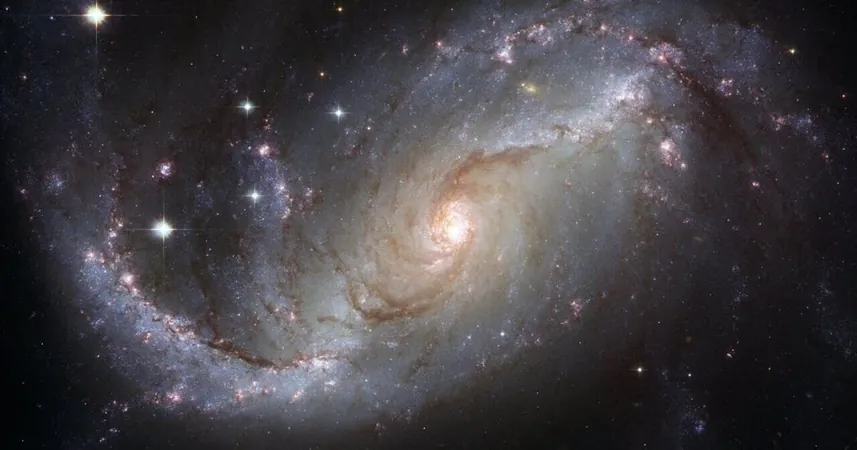
Astronomers Uncover the Source of Mysterious ‘Alien’ Signal: Shocking Revelations!
2025-01-04
Author: Ming
Introduction
In a groundbreaking discovery, astronomers have finally traced the origins of a long-mysterious “alien” signal from deep space. Fast Radio Bursts (FRBs) – brief, yet powerful signals first detected in 2007 – continue to fascinate scientists and enthusiasts alike. These bursts, lasting only a millisecond, can unleash energy equivalent to the brightness of entire galaxies, leading some experts to speculate about their extraterrestrial origins.
The Enigma of Fast Radio Bursts
For years, the exact causes of these enigmatic signals remained elusive. Thousands of FRBs have since been identified, with sources ranging from our Milky Way galaxy to galaxies located an astonishing eight billion light-years away. Still, the mechanisms behind these cosmic phenomena have sparked fierce debate within the scientific community.
Breakthrough in Understanding FRBs
Now, researchers at the Massachusetts Institute of Technology (MIT) have made strides in understanding at least one FRB thanks to a pioneering technique. This revelation, documented in the prestigious journal *Nature*, focuses on FRB 20221022A, detected from a galaxy approximately 200 million light-years away.
Scintillation Patterns and Neutron Stars
Using a method akin to observing how stars twinkle in the night sky, MIT's team studied the scintillation patterns of this specific burst. Analyzing the variations in brightness, they concluded that the FRB originated much closer to its source than previously hypothesized.
The team estimates that FRB 20221022A emanated from a region only about 10,000 kilometers away, likely near a rapidly rotating neutron star. This finding suggests that the burst may have been generated within the neutron star's magnetosphere, a highly magnetic area encasing the star. This discovery marks a pivotal moment in astrophysics, providing the first concrete proof that FRBs can emanate from such extreme environments.
Expert Insights
Dr. Kenzie Nimmo, the lead author of the study, explained, “In these powerful environments around neutron stars, magnetic fields reach peaks that challenge our understanding of physics. There has been much speculation about whether such intense radio emissions could even break free from those conditions.”
Dr. Kiyoshi Masui, an associate professor at MIT, elaborated on the implications of this discovery. He highlighted that around magnetars—neutron stars with immensely potent magnetic fields—ordinary atoms cannot exist due to the extreme conditions, leading to a unique energy release that manifests as detectable radio waves.
The Role of Advanced Technology
This uptick in FRB detections is largely attributed to innovative observational equipment, such as the Canadian Hydrogen Intensity Mapping Experiment (CHIME). This sophisticated array of stationary radio receivers has proved essential in identifying thousands of FRBs since its inception.
Innovative Research Techniques
The MIT team relied on the phenomenon of scintillation to discern the details surrounding FRB 20221022A. By studying the light bending effects caused by intervening gas in its host galaxy, they were able to essentially ‘zoom in’ on the signal’s origin. Their analysis revealed that a small gas region acted like a natural lens, allowing them to pinpoint the FRB’s source to an astonishingly limited area.
Dr. Nimmo remarked, “Being able to identify that the FRB is likely within hundreds of thousands of kilometers from its source is a game-changer. For comparison, if it had originated from a shockwave, we’d expect it to be tens of millions of kilometers away, showing no scintillation at all.”
Dr. Masui added to the excitement, saying, “To resolve a 10,000-kilometer area from 200 million light-years away is akin to measuring the width of a DNA strand from the moon’s surface. It's truly astounding.”
Future Research Directions
This landmark research opens new avenues for understanding FRBs and enhancing our comprehension of the universe’s complex physics. As the team at MIT continues their work, they aim to shed light on the diverse mechanisms driving these cosmic signals. Stay tuned, as this is just the beginning of unraveling the secrets the universe holds!

 Brasil (PT)
Brasil (PT)
 Canada (EN)
Canada (EN)
 Chile (ES)
Chile (ES)
 Česko (CS)
Česko (CS)
 대한민국 (KO)
대한민국 (KO)
 España (ES)
España (ES)
 France (FR)
France (FR)
 Hong Kong (EN)
Hong Kong (EN)
 Italia (IT)
Italia (IT)
 日本 (JA)
日本 (JA)
 Magyarország (HU)
Magyarország (HU)
 Norge (NO)
Norge (NO)
 Polska (PL)
Polska (PL)
 Schweiz (DE)
Schweiz (DE)
 Singapore (EN)
Singapore (EN)
 Sverige (SV)
Sverige (SV)
 Suomi (FI)
Suomi (FI)
 Türkiye (TR)
Türkiye (TR)
 الإمارات العربية المتحدة (AR)
الإمارات العربية المتحدة (AR)